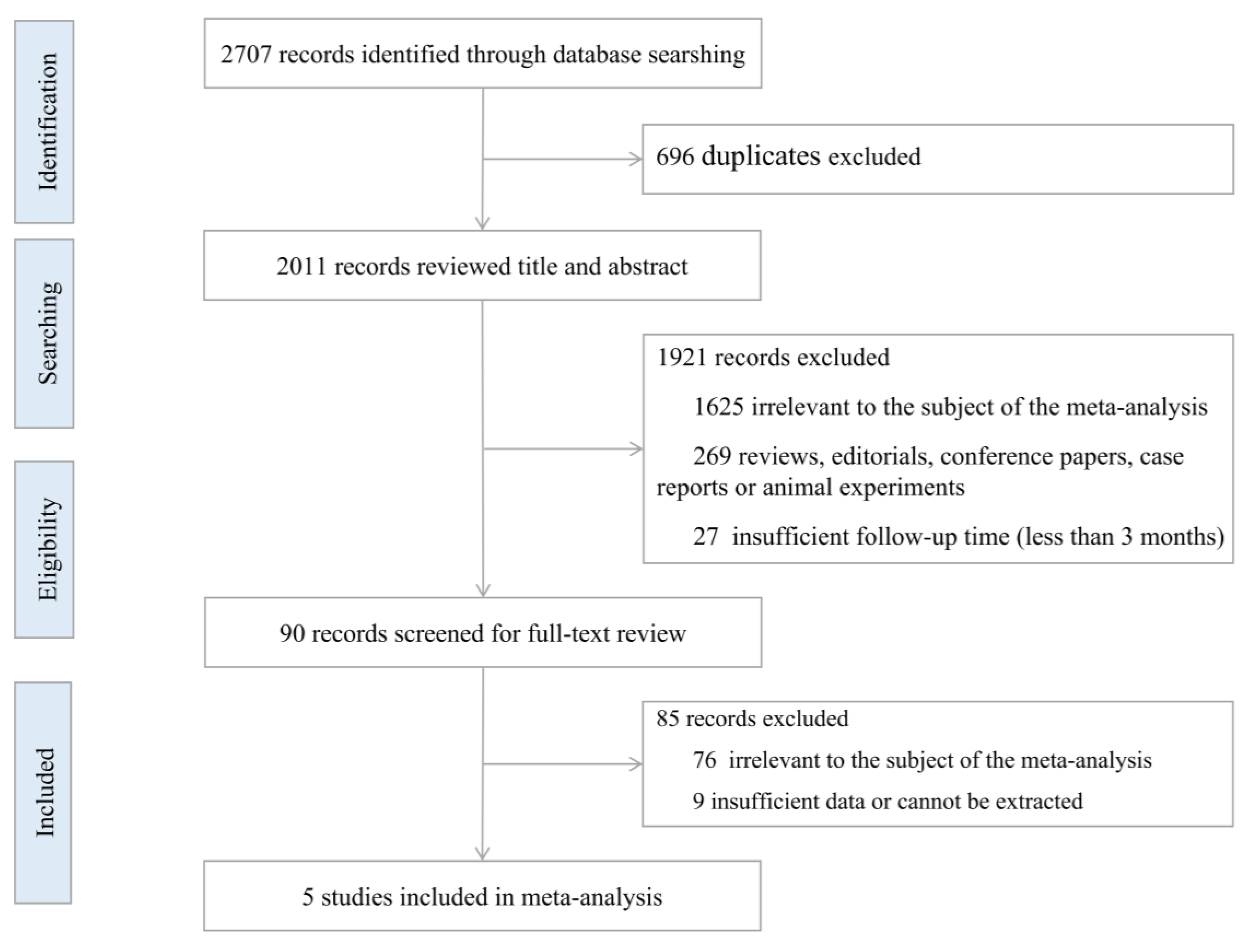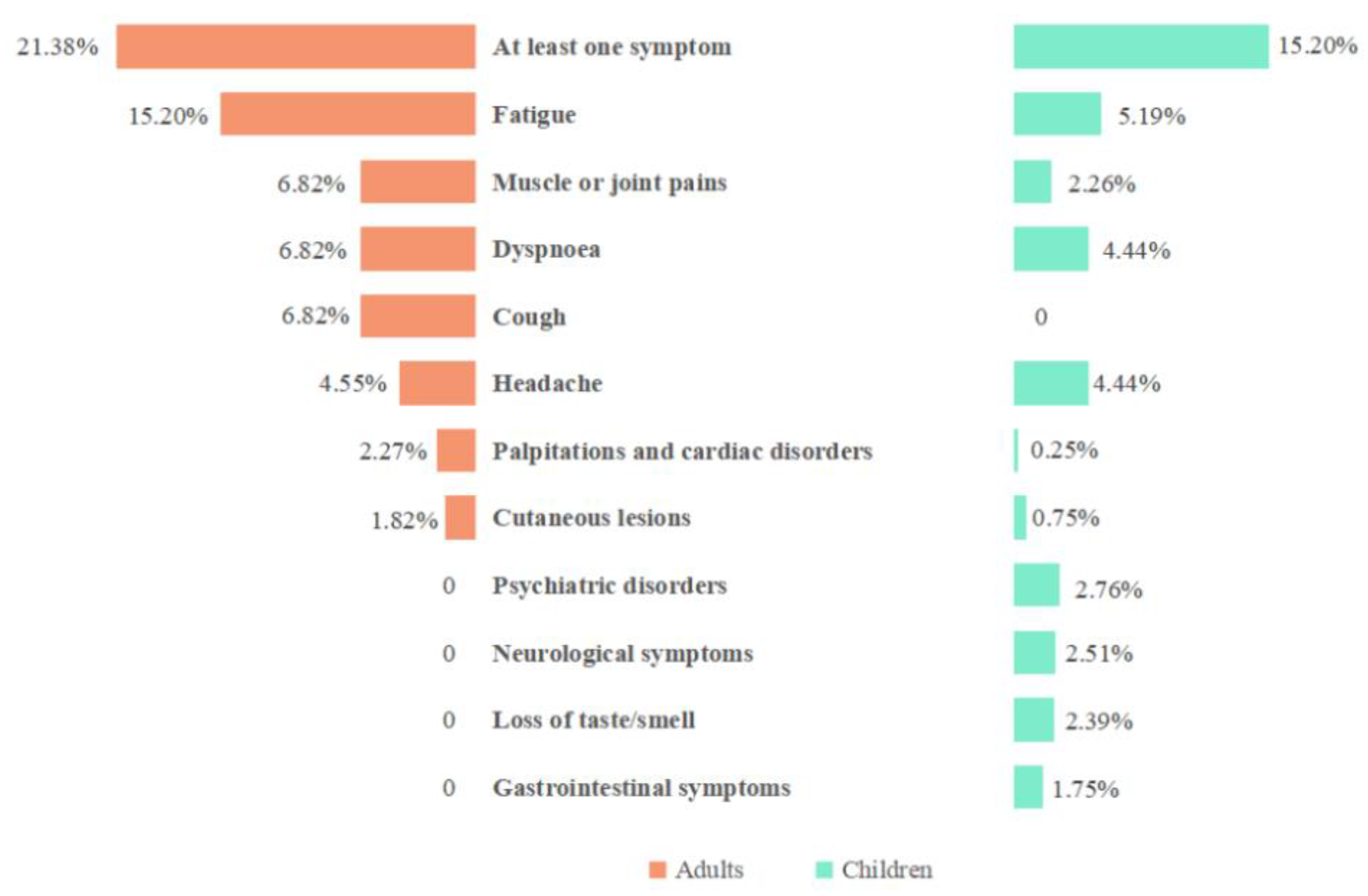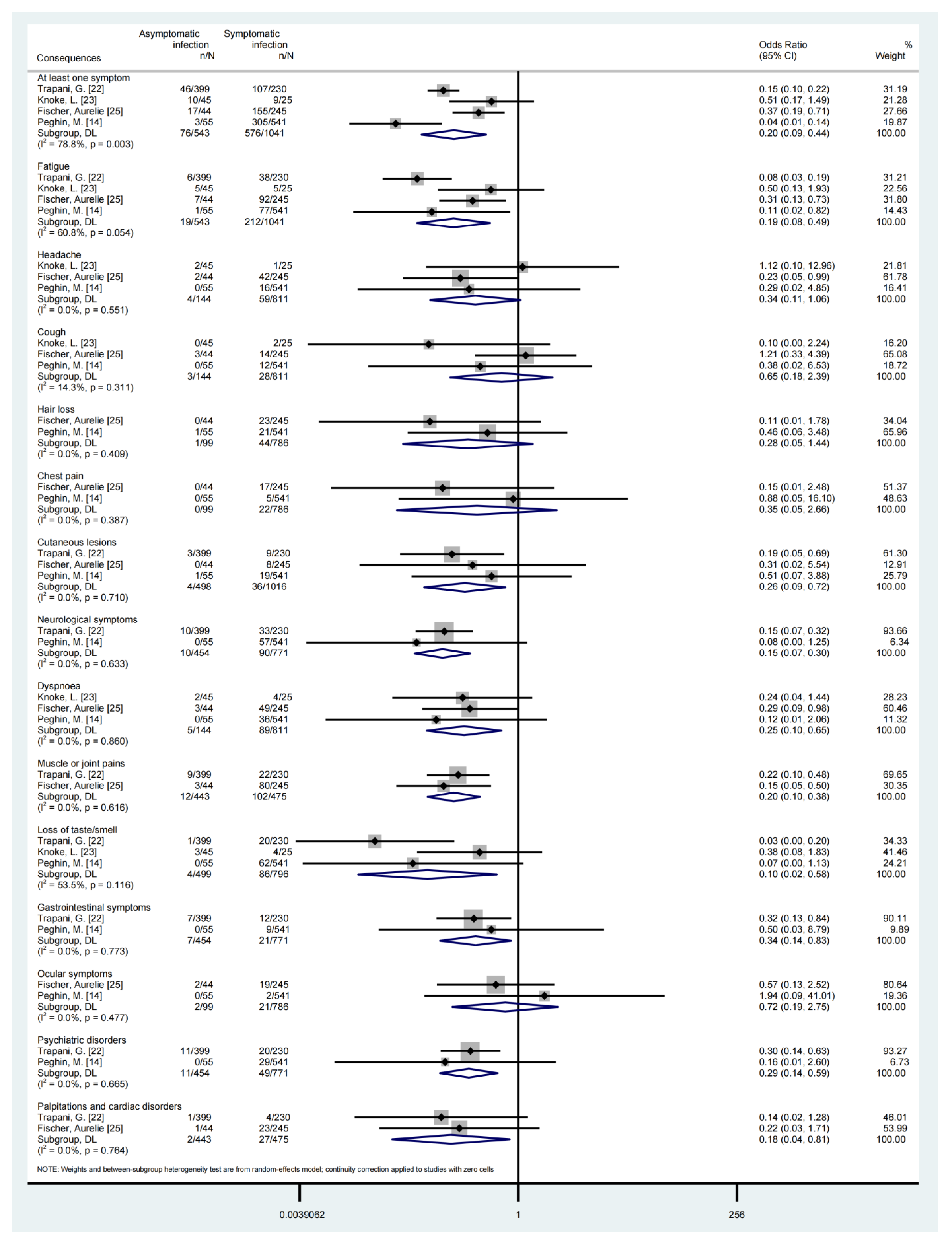Long-Term Consequences of Asymptomatic SARS-CoV-2 Infection: A Systematic Review and Meta-Analysis
Abstract
:1. Introduction
2. Methods
2.1. Search Strategy and Selection Criteria
2.2. Data Extraction
2.3. Quality Assessment and Risk of Bias
2.4. Data Synthesis and Statistical Analysis
3. Results
3.1. Basic Characteristics
3.2. Pooled Prevalence (PP) of Long-Term Consequences of Asymptomatic SARS-CoV-2 Infection
3.3. Subgroup Analysis of Pooled Prevalence (PP) of at Least One Symptom among Asymptomatic SARS-CoV-2 Infections by Sample Size, Country, Follow-Up Time, and Epidemic Period
3.4. Comparison of Long-Term Consequences of Asymptomatic and Symptomatic SARS-CoV-2 Infection
3.5. Quality Evaluation and Publication Bias
4. Discussion
5. Conclusions
Supplementary Materials
Author Contributions
Funding
Institutional Review Board Statement
Informed Consent Statement
Data Availability Statement
Conflicts of Interest
Abbreviation
| COVID-19 | coronavirus disease 2019 |
| SARS-CoV-2 | severe acute respiratory syndrome coronavirus 2 |
| WHO | World Health Organization |
| ICU | intensive care unit |
| CT | computed tomography |
| RP | recovered patient |
| PCS | Post COVID-19 Syndrome |
| LPS | lipopolysaccharide |
| PRISMA | Preferred Reporting Items for Systematic Reviews and Meta-Analyses |
| rt-PCR | reverse-transcription polymerase chain reaction |
| BMI | body mass index |
| VOC | dominant variant of concern |
| GISAID | Global Initiative on Sharing All Influenza Data |
| PP | pooled prevalence |
| CI | confidence interval |
| OR | odd ratio |
References
- Akande, O.W.; Akande, T.M. COVID-19 pandemic: A global health burden. Niger Postgrad. Med. J. 2020, 27, 147–155. [Google Scholar] [CrossRef] [PubMed]
- World Health Organization. WHO Coronavirus (COVID-19) Dashboard. Available online: https://covid19.who.int (accessed on 20 November 2022).
- Gao, Z.; Xu, Y.; Sun, C.; Wang, X.; Guo, Y.; Qiu, S.; Ma, K. A systematic review of asymptomatic infections with COVID-19. J. Microbiol. Immunol. Infect. 2021, 54, 12–16. [Google Scholar] [CrossRef] [PubMed]
- Ma, Q.; Liu, J.; Liu, Q.; Kang, L.; Liu, R.; Jing, W.; Wu, Y.; Liu, M. Global Percentage of Asymptomatic SARS-CoV-2 Infections Among the Tested Population and Individuals With Confirmed COVID-19 Diagnosis: A Systematic Review and Meta-analysis. JAMA Netw. Open 2021, 4, e2137257. [Google Scholar] [CrossRef]
- He, J.; Guo, Y.; Mao, R.; Zhang, J. Proportion of asymptomatic coronavirus disease 2019: A systematic review and meta-analysis. J. Med. Virol. 2021, 93, 820–830. [Google Scholar] [CrossRef]
- World Health Organization. WHO Director-General’s Opening Remarks at the Media Briefing on COVID-19—30 October 2020. Available online: https://www.who.int/director-general/speeches/detail/who-director-general-s-opening-remarks-at-the-media-briefing-on-covid-19---30-october-2020 (accessed on 20 November 2022).
- Soriano, J.B.; Murthy, S.; Marshall, J.C.; Relan, P.; Diaz, J.V. A clinical case definition of post-COVID-19 condition by a Delphi consensus. Lancet Infect. Dis. 2022, 22, e102–e107. [Google Scholar] [CrossRef]
- Ma, Y.; Deng, J.; Liu, Q.; Du, M.; Liu, M.; Liu, J. Long-Term Consequences of COVID-19 at 6 Months and Above: A Systematic Review and Meta-Analysis. Int. J. Environ. Res. Public Health 2022, 19, 6865. [Google Scholar] [CrossRef]
- Hastie, C.E.; Lowe, D.J.; McAuley, A.; Winter, A.J.; Mills, N.L.; Black, C.; Scott, J.T.; O’Donnell, C.A.; Blane, D.N.; Browne, S.; et al. Outcomes among confirmed cases and a matched comparison group in the Long-COVID in Scotland study. Nat. Commun. 2022, 13, 5663. [Google Scholar] [CrossRef] [PubMed]
- Global Burden of Disease Long COVID Collaborators Estimated Global Proportions of Individuals with Persistent Fatigue, Cognitive, and Respiratory Symptom Clusters Following Symptomatic COVID-19 in 2020 and 2021. JAMA 2022, 328, 1604–1615. [CrossRef] [PubMed]
- Centers for Disease Control and Prevention. Long COVID or Post-COVID Conditions. Available online: https://www.cdc.gov/coronavirus/2019-ncov/long-term-effects/index.html (accessed on 20 November 2022).
- Al-Aly, Z.; Bowe, B.; Xie, Y. Long COVID after breakthrough SARS-CoV-2 infection. Nat. Med. 2022, 28, 1461–1467. [Google Scholar] [CrossRef]
- Azzolini, E.; Levi, R.; Sarti, R.; Pozzi, C.; Mollura, M.; Mantovani, A.; Rescigno, M. Association Between BNT162b2 Vaccination and Long COVID After Infections Not Requiring Hospitalization in Health Care Workers. JAMA 2022, 328, 676–678. [Google Scholar] [CrossRef]
- Peghin, M.; Palese, A.; Venturini, M.; De Martino, M.; Gerussi, V.; Graziano, E.; Bontempo, G.; Marrella, F.; Tommasini, A.; Fabris, M.; et al. Post-COVID-19 symptoms 6 months after acute infection among hospitalized and non-hospitalized patients. Clin. Microbiol. Infect. Off. Publ. Eur. Soc. Clin. Microbiol. Infect. Dis. 2021, 27, 1507–1513. [Google Scholar] [CrossRef] [PubMed]
- Zhou, M.; Xu, J.; Liao, T.; Yin, Z.; Yang, F.; Wang, K.; Wang, Z.; Yang, D.; Wang, S.; Peng, Y.; et al. Comparison of Residual Pulmonary Abnormalities 3 Months After Discharge in Patients Who Recovered From COVID-19 of Different Severity. Front. Med. 2021, 8, 682087. [Google Scholar] [CrossRef] [PubMed]
- Malkova, A.; Kudryavtsev, I.; Starshinova, A.; Kudlay, D.; Zinchenko, Y.; Glushkova, A.; Yablonskiy, P.; Shoenfeld, Y. Post COVID-19 Syndrome in Patients with Asymptomatic/Mild Form. Pathogens 2021, 10, 1408. [Google Scholar] [CrossRef]
- Say, D.; Crawford, N.; McNab, S.; Wurzel, D.; Steer, A.; Tosif, S. Post-acute COVID-19 outcomes in children with mild and asymptomatic disease. Lancet Child Adolesc. Health 2021, 5, e22–e23. [Google Scholar] [CrossRef] [PubMed]
- Parums, D.V. Editorial: Long-Term Effects of Symptomatic and Asymptomatic SARS-CoV-2 Infection in Children and the Changing Pathogenesis of Common Childhood Viruses Driven by the COVID-19 Pandemic. Med. Sci. Monit. 2022, 28, e937927. [Google Scholar] [CrossRef] [PubMed]
- Tang, O.; Bigelow, B.F.; Sheikh, F.; Peters, M.; Zenilman, J.M.; Bennett, R.; Katz, M.J. Outcomes of Nursing Home COVID-19 Patients by Initial Symptoms and Comorbidity: Results of Universal Testing of 1970 Residents. J. Am. Med. Dir. Assoc. 2020, 21, 1767. [Google Scholar] [CrossRef] [PubMed]
- Page, M.J.; McKenzie, J.E.; Bossuyt, P.M.; Boutron, I.; Hoffmann, T.C.; Mulrow, C.D.; Shamseer, L.; Tetzlaff, J.M.; Akl, E.A.; Brennan, S.E.; et al. The PRISMA 2020 statement: An updated guideline for reporting systematic reviews. BMJ (Clin. Res. Ed). 2021, 372, n71. [Google Scholar]
- Genomic Epidemiology of SARS-CoV-2 with Subsampling Focused Globally. Available online: https://gisaid.org/phylodynamics/global/nextstrain/ (accessed on 6 November 2022).
- Trapani, G.; Verlato, G.; Bertino, E.; Maiocco, G.; Vesentini, R.; Spadavecchia, A.; Dessì, A.; Fanos, V. Long COVID-19 in children: An Italian cohort study. Ital. J. Pediatr. 2022, 48, 83. [Google Scholar] [CrossRef]
- Knoke, L.; Schlegtendal, A.; Maier, C.; Eitner, L.; Lücke, T.; Brinkmann, F. Pulmonary Function and Long-Term Respiratory Symptoms in Children and Adolescents After COVID-19. Front. Pediatr. 2022, 10, 851008. [Google Scholar] [CrossRef]
- Appelt, P.A.; Sisconetto, A.T.; Minare Baldo Sucupira, K.S.; de Moura Neto, E.; Chagas, T.d.J.; Bazan, R.; Cabral, A.M.; Andrade, A.d.O.; Pascucci Sande de Souza, L.A.; Luvizutto, G.J. Changes in Electrical Brain Activity and Cognitive Functions Following Mild to Moderate COVID-19: A one-Year Prospective Study After Acute Infection. Clin. Eeg Neurosci. 2022, 53, 543–557. [Google Scholar] [CrossRef]
- Fischer, A.; Zhang, L.; Elbeji, A.; Wilmes, P.; Oustric, P.; Staub, T.; Nazarov, P.V.; Ollert, M.; Fagherazzi, G. Long COVID Symptomatology After 12 Months and Its Impact on Quality of Life According to Initial Coronavirus Disease 2019 Disease Severity. Open Forum Infect. Dis. 2022, 9, ofac397. [Google Scholar] [CrossRef] [PubMed]
- Baggio, S.; L’Huillier, A.G.; Yerly, S.; Bellon, M.; Wagner, N.; Rohr, M.; Huttner, A.; Blanchard-Rohner, G.; Loevy, N.; Kaiser, L.; et al. Severe Acute Respiratory Syndrome Coronavirus 2 (SARS-CoV-2) Viral Load in the Upper Respiratory Tract of Children and Adults With Early Acute Coronavirus Disease 2019 (COVID-19). Clin. Infect. Dis. Off. Publ. Infect. Dis. Soc. Am. 2021, 73, 148–150. [Google Scholar] [CrossRef] [PubMed]
- Lingappan, K.; Karmouty-Quintana, H.; Davies, J.; Akkanti, B.; Harting, M.T. Understanding the age divide in COVID-19: Why are children overwhelmingly spared? Am. J. Physiol. Lung Cell. Mol. Physiol. 2020, 319, L39–L44. [Google Scholar] [CrossRef] [PubMed]
- Bunyavanich, S.; Do, A.; Vicencio, A. Nasal Gene Expression of Angiotensin-Converting Enzyme 2 in Children and Adults. JAMA 2020, 323, 2427–2429. [Google Scholar] [CrossRef] [PubMed]
- Ying, L.; Alvira, C.M.; Cornfield, D.N. Developmental differences in focal adhesion kinase expression modulate pulmonary endothelial barrier function in response to inflammation. Am. J. Physiol. Lung Cell. Mol. Physiol. 2018, 315, L66–L77. [Google Scholar] [CrossRef]
- Adler, L.; Gazit, S.; Pinto, Y.; Perez, G.; Mizrahi Reuveni, M.; Yehoshua, I.; Hoffman, R.; Azuri, J.; Patalon, T. Long-COVID in patients with a history of mild or asymptomatic SARS-CoV-2 infection: A Nationwide Cohort Study. Scand. J. Prim. Health Care 2022, 40, 342–349. [Google Scholar] [CrossRef]
- Vicenti, I.; Gatti, F.; Scaggiante, R.; Boccuto, A.; Modolo, E.; Zago, D.; Basso, M.; Dragoni, F.; Bartolini, N.; Zazzi, M.; et al. Time Course of Neutralizing Antibody in Health Care Workers with Mild or Asymptomatic COVID-19 Infection. Open Forum Infect. Dis. 2021, 8, ofab312. [Google Scholar] [CrossRef]
- Jalkanen, P.; Kolehmainen, P.; Häkkinen, H.K.; Huttunen, M.; Tähtinen, P.A.; Lundberg, R.; Maljanen, S.; Reinholm, A.; Tauriainen, S.; Pakkanen, S.H.; et al. COVID-19 mRNA vaccine induced antibody responses against three SARS-CoV-2 variants. Nat. Commun. 2021, 12, 3991. [Google Scholar] [CrossRef]



| Consequences | Data Source | Patients n/N | PP(%) | 95%CI(%) | p-Value | I2(%) | p-Heterogeneity |
|---|---|---|---|---|---|---|---|
| At least one symptom | 1, 2, 4, 5 | 76/543 | 17.13 | 7.55–26.71 | <0.05 | 85.40 | <0.05 |
| Loss of taste | 3, 4 | 8/97 | 15.09 | 5.46–24.73 | <0.05 | - | - |
| Loss of smell | 3, 4 | 15/97 | 14.14 | −1.32–29.61 | >0.05 | 81.00 | <0.05 |
| Fatigue | 1, 2, 3, 4, 5 | 35/596 | 9.33 | 3.07–15.60 | <0.05 | 87.00 | <0.05 |
| Cough | 2, 4, 5 | 3/144 | 6.82 | −0.63–14.27 | >0.05 | - | - |
| Dyspnoea | 4, 5 | 5/144 | 5.38 | 0.70–10.07 | <0.05 | 0.00 | >0.05 |
| Ocular symptoms | 4, 5 | 2/99 | 4.55 | −1.61–10.70 | >0.05 | - | - |
| Headache | 2, 4, 5 | 4/144 | 4.49 | 0.19–8.80 | <0.05 | 0.00 | >0.05 |
| Muscle or joint pains | 1, 4 | 12/443 | 3.11 | −0.32–6.35 | >0.05 | 28.00 | >0.05 |
| Psychiatric disorders | 1, 5 | 11/454 | 2.76 | 1.15–4.36 | <0.05 | - | - |
| Neurological symptoms | 4, 5 | 10/454 | 2.51 | 0.97–4.04 | <0.05 | - | - |
| Loss of taste/smell | 1, 2, 5 | 4/499 | 2.39 | −3.54–8.31 | >0.05 | 66.30 | >0.05 |
| Hair loss | 4, 5 | 1/99 | 1.82 | −1.71–5.35 | >0.05 | - | - |
| Gastrointestinal symptoms | 1, 5 | 7/454 | 1.75 | 0.47–3.04 | <0.05 | - | - |
| Cutaneous lesions | 4, 5 | 4/498 | 0.81 | −0.01–1.63 | >0.05 | 0.00 | >0.05 |
| Palpitations and cardiac disorders | 1, 4 | 2/443 | 0.28 | −0.21–0.76 | >0.05 | 0.00 | >0.05 |
| Chest pain | 4, 5 | 0/99 | - | - | - | - | - |
| Subgroups | Data Source | Patients n/N | PP(%) | 95%CI(%) | p-Value | I2(%) | p-Heterogeneity | |
|---|---|---|---|---|---|---|---|---|
| Age group | Adults | 1, 2, 4, 5 | 20/99 | 21.38 | −11.12–53.87 | >0.05 | 94.30 | <0.05 |
| Children | 56/444 | 15.20 | 5.25–25.15 | <0.05 | 64.20 | >0.05 | ||
| Sample size | <100 | 1, 2, 4, 5 | 30/144 | 21.27 | 1.71–40.83 | <0.05 | 90.20 | <0.05 |
| ≥100 | 46/399 | 11.53 | 8.40–14.66 | <0.05 | - | - | ||
| Country | Italy | 1, 2, 4, 5 | 49/454 | 9.05 | 3.20–14.90 | <0.05 | 67.70 | >0.05 |
| Germany | 10/45 | 22.22 | 10.08–34.37 | <0.05 | - | - | ||
| Luxembourg | 17/44 | 38.64 | 24.25–53.02 | <0.05 | - | - | ||
| Follow-up time | <12 months | 1, 2, 4, 5 | 59/499 | 11.35 | 4.76–17.95 | <0.05 | 69.90 | <0.05 |
| ≥12 months | 17/44 | 38.64 | 24.25–53.02 | <0.05 | - | - | ||
| Epidemic period | non-VOCs period | 1, 2, 4, 5 | 56/444 | 15.20 | 5.25–25.15 | <0.05 | 64.20 | >0.05 |
| VOCs period | 20/99 | 21.38 | −11.12–53.87 | >0.05 | 94.30 | <0.05 | ||
| Overall | 1, 2, 4, 5 | 76/543 | 17.13 | 7.55–26.71 | <0.05 | 85.40 | <0.05 | |
| Consequences | Severity of COVID-19 Disease | |||
|---|---|---|---|---|
| Asymptomatic Infection | Symptomatic Infection | |||
| Total | Mild Cases | Moderate/Severe Cases | ||
| At least one symptom | 17.13 (7.55–26.71) * | 53.02 (44.54–61.49) * | 48.19 (32.78–63.60) * | 66.54 (34.86–98.23) * |
| Fatigue | 9.33 (3.07–15.60) * | 22.07 (11.18–32.95) * | 20.48 (1.42–39.54) * | 40.05 (4.39–75.71) * |
| Headache | 4.49 (0.19–8.80) * | 8.06 (−1.78–17.90) | 8.65 (−5.44–22.73) | 12.20 (−6.36–30.76) |
| Loss of smell | 14.14 (−1.32–29.61) | - | - | - |
| Cough | 6.82 (−0.63–14.27) | 4.02 (0.88–7.15) * | 2.15 (0.67–3.62) * | 7.75 (−2.28–17.78) |
| Hair loss | 1.82 (−1.71–5.35) | 6.38 (1.01–11.76) * | 6.49 (0.79–12.19) * | 4.13 (1.19–7.06) * |
| Loss of taste | 15.09 (5.46–24.73) * | - | - | - |
| Chest pain | - | 3.73 (−2.15 -9.61) | 2.36 (−1.38–6.10) | 7.85 (−5.60–21.30) |
| Cutaneous lesions | 0.81 (−0.01–1.63) | 3.53 (2.40–4.67) * | 3.60 (2.09–5.11) * | 2.80 (0.36–5.25) * |
| Neurological symptoms | 2.51 (0.97–4.04) * | 11.97 (8.35–15.59) * | - | - |
| Dyspnoea | 5.38 (0.70–10.07) * | 13.78 (2.97–24.60) * | 9.84 (0.49–19.20) * | 23.97 (−5.66–53.59) |
| Muscle or joint pains | 3.11 (−0.32–6.35) | 21.00 (−1.63–43.62) | - | - |
| Loss of taste/smell | 2.39 (−3.54–8.31) | 10.61 (8.47–12.75) * | - | - |
| Gastrointestinal symptoms | 1.75 (0.47–3.04) * | 3.18 (−0.27–6.63) | - | - |
| Ocular symptoms | 4.51 (−1.61–10.70) | 3.87 (−3.36–11.10) | 3.12 (−2.57–8.81) | 12.07 (3.69–20.45) * |
| Psychiatric disorders | 2.76 (1.15–4.36) * | 6.65 (3.47–9.84) * | - | - |
| Palpitations and cardiac disorders | 0.28 (−0.21–0.76) | 5.39 (−2.10–12.87) | - | - |
| Consequences | Data Source | Asymptomatic Infection n/N | Symptomatic Infection n/N | OR | 95%CI | p-Value | I2 (%) | p-Heterogeneity |
|---|---|---|---|---|---|---|---|---|
| At least one symptom | 1, 2, 4, 5 | 76/543 | 576/1041 | 0.20 | 0.09–0.45 | <0.05 | 79.40 | <0.05 |
| Fatigue | 1, 2, 4, 5 | 19/543 | 212/1041 | 0.19 | 0.08–0.49 | <0.05 | 61.30 | <0.05 |
| Headache | 2, 4, 5 | 4/144 | 59/811 | 0.34 | 0.12–1.06 | >0.05 | 0.00 | >0.05 |
| Cough | 2, 4, 5 | 3/144 | 28/811 | 0.64 | 0.17–2.43 | >0.05 | 17.10 | >0.05 |
| Hair loss | 4, 5 | 1/99 | 44/786 | 0.28 | 0.05–1.45 | >0.05 | 0.00 | >0.05 |
| Chest pain | 4, 5 | 0/99 | 22/786 | 0.35 | 0.05–2.66 | >0.05 | 0.00 | >0.05 |
| Cutaneous lesions | 1, 4, 5 | 4/498 | 36/1016 | 0.26 | 0.09–0.72 | <0.05 | 0.00 | >0.05 |
| Neurological symptoms | 1, 5 | 10/454 | 90/771 | 0.15 | 0.07–0.30 | <0.05 | 0.00 | >0.05 |
| Dyspnoea | 2, 4, 5 | 5/144 | 89/811 | 0.25 | 0.10–0.65 | <0.05 | 0.00 | >0.05 |
| Muscle or joint pains | 1, 4 | 12/443 | 102/475 | 0.20 | 0.10–0.38 | <0.05 | 0.00 | >0.05 |
| Loss of taste/smell | 1, 2, 5 | 4/499 | 86/796 | 0.10 | 0.02–0.58 | <0.05 | 53.50 | >0.05 |
| Gastrointestinal symptoms | 1, 5 | 7/454 | 21/771 | 0.34 | 0.14–0.83 | <0.05 | 0.00 | >0.05 |
| Ocular symptoms | 4, 5 | 2/99 | 21/786 | 0.72 | 0.19–2.75 | >0.05 | 0.00 | >0.05 |
| Psychiatric disorders | 1, 5 | 11/454 | 49/771 | 0.28 | 0.14–0.59 | <0.05 | 0.00 | >0.05 |
| Palpitations and cardiac disorders | 1, 4 | 2/443 | 27/475 | 0.18 | 0.04–0.81 | <0.05 | 0.00 | >0.05 |
Disclaimer/Publisher’s Note: The statements, opinions and data contained in all publications are solely those of the individual author(s) and contributor(s) and not of MDPI and/or the editor(s). MDPI and/or the editor(s) disclaim responsibility for any injury to people or property resulting from any ideas, methods, instructions or products referred to in the content. |
© 2023 by the authors. Licensee MDPI, Basel, Switzerland. This article is an open access article distributed under the terms and conditions of the Creative Commons Attribution (CC BY) license (https://creativecommons.org/licenses/by/4.0/).
Share and Cite
Ma, Y.; Deng, J.; Liu, Q.; Du, M.; Liu, M.; Liu, J. Long-Term Consequences of Asymptomatic SARS-CoV-2 Infection: A Systematic Review and Meta-Analysis. Int. J. Environ. Res. Public Health 2023, 20, 1613. https://doi.org/10.3390/ijerph20021613
Ma Y, Deng J, Liu Q, Du M, Liu M, Liu J. Long-Term Consequences of Asymptomatic SARS-CoV-2 Infection: A Systematic Review and Meta-Analysis. International Journal of Environmental Research and Public Health. 2023; 20(2):1613. https://doi.org/10.3390/ijerph20021613
Chicago/Turabian StyleMa, Yirui, Jie Deng, Qiao Liu, Min Du, Min Liu, and Jue Liu. 2023. "Long-Term Consequences of Asymptomatic SARS-CoV-2 Infection: A Systematic Review and Meta-Analysis" International Journal of Environmental Research and Public Health 20, no. 2: 1613. https://doi.org/10.3390/ijerph20021613
APA StyleMa, Y., Deng, J., Liu, Q., Du, M., Liu, M., & Liu, J. (2023). Long-Term Consequences of Asymptomatic SARS-CoV-2 Infection: A Systematic Review and Meta-Analysis. International Journal of Environmental Research and Public Health, 20(2), 1613. https://doi.org/10.3390/ijerph20021613







